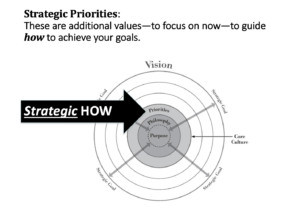Strategic Priorities: values that enable the organization to achieve its goals
Strategic Priorities are the values to focus on and pay attention to–now–in order to achieve your goals.
As you see in the image below, strategic Priorities are a part of the Core Culture. To clarify, they are core values but not the distinctive values of the organization. Instead, they are the values that align with the organization’s vision and goals. Incorporating these strategic Priorities into the core of the culture ensures that the culture will support organizational success.

Core Culture and strategy are intertwined. To explain, you must align your strategy with your Core Culture. And, similarly, your Core Culture must support your strategy. When they are in sync, you are focused and positioned to accomplish the goals you envision.
The organization’s Core Culture must support the strategy. Otherwise, employees will not have an aligned focus. This is where most organizations fail. They have the strategy defined, but they lack the culture to nurture its realization. This link is vital.
Only a few strategic Priorities should be central to all areas of the organization.
Evaluate strategic Priorities based on how well they will contribute to achieving your goals. These Priorities are relatively stable, but you can change them to enhance your organization’s ability to thrive.
When your organization is undergoing change, consider altering its strategic Priorities instead of its Purpose or Philosophy. Changing Priorities is a significant change. But it does not tamper with the identity of the organization. Above all, be sure that you align the new strategic Priorities with the Purpose and the Philosophy.
Strategic Priorities example: Health & Safety
Think about the issues in the news. Most organizations are adapting to a new disease that has created a global health and economic crisis. Companies have changed their Priorities to have this new focus.
 For most companies, a new Priority is a heightened focus on health and safety. Consequently, for example, there is a need for implementing virtual work practices for employees. Also, for those coming into the office, health and safety has become a prime focus. New Practices have similarly been implemented to support customer health and safety.
For most companies, a new Priority is a heightened focus on health and safety. Consequently, for example, there is a need for implementing virtual work practices for employees. Also, for those coming into the office, health and safety has become a prime focus. New Practices have similarly been implemented to support customer health and safety.
Strategic Priorities example: Digital
Was your company ready for the biggest stress test that came with the pandemic? Did you have the digital capability in place for employees to work virtually? Did you have the digital capability in place to have customers shop and buy digitally? For most companies, this digital Priority became an obvious value to focus on and pay attention to.
Strategic Priorities example: Sustainability
More and more, companies have adopted the strategic Priority of sustainability. They seek to use their company to help people live better and preserve the planet. The focus on sustainability has increased over the years. For some companies like Tesla, the focus on sustainability is a part of its identity. But for most companies, it is a strategic Priority that companies see as necessary in order to thrive.
In summary, the five strategic Priority criteria
- Firstly, is it a key value and important standard to guide behavior now?
- Secondly, is this value important to all areas of the organization?
- Next, if we abide by this value, will we enhance our ability to thrive?
- Most importantly, is this value aligned with the Purpose and Philosophy?
- Likewise, does this value support our strategy and goals?
Key points about strategic Priorities
- They are key values that guide work. They are standards for behavior that direct how you put the Purpose and Philosophy into practice.
- You should have a small number of strategic values.
- To clarify, they are important to all areas of the organization. These Priorities are those few values that, when followed by everyone, will enhance the competitiveness of the organization. They will enable it to thrive.
- These values are relatively stable, but you can alter them to embed change in your culture. Be sure any new Priorities are aligned with the Purpose and the Philosophy.
Contact Sheila to uncover your strategic Priorities
Sheila is President of Workplace Culture Institute, LLC. To clarify, her management consulting firm is based in Atlanta, serving companies globally.
To sum up, Sheila conducts cultural assessments and employee engagement surveys, and facilitates culture change.
Use the Contact Form to email Sheila.